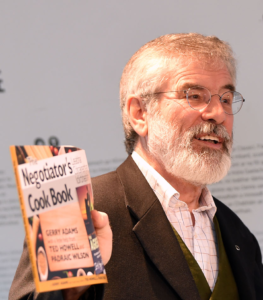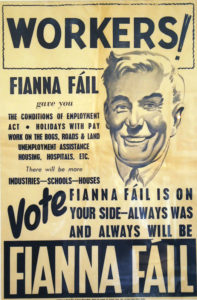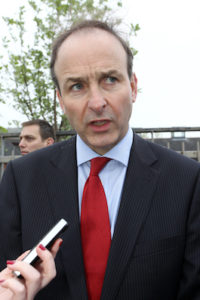Notwithstanding the primacy and priority that the pandemic deserves, not least because of the deaths and distress it is causing, I want to return to the need for a Government for Change in Dublin. In fact the pandemic and the recovery from it requires such a government.

GERRY ADAMS: Surge in republican vote
In the days before the February general election I described that election as part of the necessary process of the realignment of politics on the island of Ireland. I also remarked that this process has been slow and hesitant at times but that if republicans do our work well – think strategically, organise, be energetic and rooted, never give up and stay focused on the future, that a tipping point can emerge – a space in which significant and historic change is possible. I said: “This election looks like being such an event.”
It was. Although few – me included – foresaw the strength of the surge in the republican vote.
Sinn Féin won the popular vote and set about trying to put in place a government for change with those like-minded parties and individual TDs who had campaigned for change. That work is ongoing. The options are limited but it’s a long game and it’s not over until it’s over.
Fianna Fáil and Fine Gael insist that they will not talk to Sinn Féin about government formation. Just like the unionists used to do. It is deeply insulting, and totally unacceptable for anyone to disrespect and refuse to accept all voters as legitimate citizens whose votes are equal to every other vote. The support for this anti-democratic posture by sections of the media is also reprehensible. Shame on them all.
FLUMMOXED
The establishment were flummoxed when Sinn Féin won the popular vote and emerged, following the election of An Ceann Chomhairle, with the same number of elected TDs as Fianna Fáil and more than Fine Gael. For the first time ever, Fianna Fáil and Fine Gael took less than 50% of the vote.
Micheál Martin. who was behaving like An Taoiseach-in-Waiting, was shell-shocked. Large sections of the electorate were clearly opting for change. Mr Martin was not one of them. Like Mr Varadkar, his vision is conservative and confined by and large to preserving the status quo in the southern state. A consequence, in part, of a hundred years of partition allied to a desire to hold on to power.
Both he and Leo Varadkar repeatedly rubbished any suggestion that they might enter coalition together. Micheál Martin said in January that “any government involving Fine Gael is not change.” He later said: “We will not be entering into a grand coalition... the people want change... they want Fine Gael out of office... they’ve been there too long... they haven’t delivered on the key issues of housing and health and the impact of the costs living.” He described any u-turn on a coalition with Fine Gael as “Jekyll and Hyde behaviour”.
Would #FineGael ever go into coalition with #SinnFéin ?
— Esteban (@ActingTheGom) February 9, 2020
😅😅😅😅#GE2020 pic.twitter.com/AyQ40MR4DG
Fianna Fáil and Fine Gael have been election rivals for almost 100 years. The two parties emerged out of the violence and chaos of the Civil War. Cumann na nGaedheal governed the Irish Free State – established under partition – until 1932. It lost the general election that year to Fianna Fáil, which had split from Sinn Féin in 1926. In 1933, Cumann na nGaedheal merged with the right wing National Centre Party and the fascist Blueshirts to form Fine Gael.
ANTI-TREATY PARTY
Fianna Fáil posed as the anti-Treaty Republican Party. Fine Gael was the pro-Treaty party. Each was and is conservative and their economic record and policies reflect this. Fianna Fáil had a more populist approach which attracted a greater number of working class votes.
From 1932 every government formed in the South had either Fianna Fáil or Fine Gael at their heart, often attracting over 70 per cent of the votes. During this time they did very little to tackle the festering sore of discrimination in the north or any of the other evils of partition. Or the inequalities in their own state.

"DID LITTE TO TACKLE PARTITION": 1948 Fianna Fáil election poster
However, in the 2016 general election this cosy arrangement of alternating power between these two parties began to falter. Fianna Fáil was the party largely responsible for the economic crash in 2008 and the subsequent horrendous deal with the Troika which handcuffed citizens for decades to come to a €50 billion banking debt. Hundreds of thousands lost their jobs and many families saw sons and daughters emigrating to find employment. When Fianna Fáil was kicked out of office in 2011 Fine Gael and Labour ruthlessly implemented austerity policies that imposed huge hardship on citizens and cut public services to the bone, especially in the provision of housing and in the Health Service.
Little wonder the government had to scramble to shore up these depleted services in the face of the pandemic. As always the people, particularly health workers and other frontline workers, responded with great courage and willingness to help out those most at risk. Solidarity, community, fairness and decency were and remain the core values embraced by most citizens.
The logic of the two conservative parties merging has long been mooted as a logical outcome of the sameness of their policies and politics. Following the 2016 general election, there was intense speculation and debate once again around this possibility. Micheál Martin was explicit: “...the best interests of the Irish people are not served by a government made up of Fianna Fáil and Fine Gael. We made it very clear to the Irish people and those voting for us that we would not go into government with Fine Gael and we’re remaining consistent and true to that commitment.”
They came up with the next best option to serve their selfish self-interest – the confidence and supply agreement. For four years Fianna Fáil kept Fine Gael in power while pretending that they weren’t really in partnership and culpable for the crises in housing, homelessness and health. But this time the electorate were not fooled.
ESTABLISHMENT MEDIA
Then the awful pandemic kicked in and understandably the issue of government formation receded in public consciousness as we all came to terms with this dreadful plague.
Fianna Fáil and Fine Gael have now produced their Framework document. Its grandiose title is ‘A draft document between Fianna Fáil and Fine Gael to facilitate negotiations with other parties on a plan to recover, rebuild and renew Ireland after the Covid-19 Emergency’.
As Pearse Doherty has pointed out, if Sinn Féin had published this document we would have been ridiculed, quite rightly, by the establishment media. It is dishonest, full of vague generalisations and aspirations, with no specific plans, timetables, targets, costings or policy detail. It’s a wish list with no substance.
Its primary aim is to keep Sinn Fein out of government and put Fianna Fáil and Fine Gael in government. It cannot deliver the kind of change that the majority of citizens in the south voted for in February. Why should citizens, or the smaller parties and independents being courted by them, trust Fianna Fáil and Fine Gael? These parties are responsible for the very crises they now claim they want to end.
Their only firm economic commitment is that a FFFG government will comply with the strict conservative European fiscal rules. That can only mean a further squeeze on public services. Surely one of the big lessons of the pandemic crisis is the need, and the entitlement of citizens, to health care, childcare and eldercare as a right. Surely that’s the least the State should do in the common good. That means challenging the EU rules, not blindly complying with them.
The looming economic crisis resulting from Covid-19 also highlights the common sense need for the island of Ireland to confront these significant economic challenges on an all-Ireland basis. Our ability to co-ordinate and maximise our economic response, transform our healthcare services, protect our agricultural and agri-food sector and produce an effective climate change policy to meet the climate emergency, would all be more effective in an all-island context.
DISASTROUS
The approach of the British government has been disastrous. Boris Johnson is a disgrace. It makes no sense for anyone in Ireland to follow his policies, such as they are. It makes sense to have an all-Ireland approach to Covid 19 – that is what Mary Lou and Michelle O’Neill and Sinn Féin’s Ministerial team have been pushing. We have had an all island approach for animal health. We need an all island approach for human health. We have a huge advantage as an island nation and as we exit this pandemic this is critical.
In the section of their Agreement entitled ‘Mission: A Shared Island’, Fianna Fáil the so-called ‘Republican Party’ and Fine Gael the so-called ‘United Ireland’ party, couldn’t bring themselves to even use the term ‘United Ireland’. Their ‘Shared Ireland’ section contains nothing new. The commitment to establish a “Unit within the Department of An Taoiseach to work towards a consensus on a united island” is a lift from Fianna Fáil’s 2020 election manifesto in January. It falls short of what is required to plan for the future. What now of Simon Coveney’s assertion: "I would like to see a united Ireland in my lifetime – if possible, in my political lifetime.”
I wonder did he bother putting this forward? Or did Micheál Martin knock him back? Leo Varadkar has similar lines on unity. Did he put forward any of these? 0r the proposals coming from civic society north and South which he received in a letter last November calling for the setting up of a “Citizens Assembly reflecting the views of citizens north and south, or a Forum to discuss the future and achieve maximum consensus on a way forward.” If he didn’t, why not?

PROMISES: Micheál Martin TD
And what of Micheál Martin’s promise that FF would “soon” produce a white paper on unity? That was nine years ago. Three years ago he promised a 12-point plan of “concrete proposals” on unity. No sign of that in the new Agreement. Or anywhere else.
The truth is while acknowledging the importance of the Good Friday Agreement – what other choice have they? – the FFFG Framework document runs away from the need to plan for and win the referendum on unity which is a core commitment of the Agreement.
Its attitude on this important issue reflects its position on all the other primary issues. Rural Ireland barely gets a mention. There is no coherent plan to tackle homelessness. Or childcare. The cost of living crisis. Eldercare. Climate justice.
The National Women’s Council says the FFFG document will not provide a recovery for women: “Equality is not included in its values, showing a failure to understand the breadth and depth of inequality that exists in society.”
INEQUALITIES OF POWER
Inequalities in society are not inherent. They are caused by inequalities of power. It takes political vision and political will to change this. It can be done. But not by a FFFG government.
Building an Ireland of Equals is one of Sinn Féin’s core objectives. In the general election Sinn Féin set out practical costed measures to tackle inequalities. Our main spokespersons, led by Mary Lou McDonald, were, and are, head and shoulders above their counterparts in the other parties. They were coherent, committed and passionate about can-do measures to resolve the housing and health crisis as well as Irish unity, childcare and the other challenges faced by working families and senior citizens at the hands of bankers, insurance companies, vulture funds and landlords.
Look at the much-vaunted ‘takeover’ of private hospitals. I said at that time that it would be good to see the small print of that deal. However, the contractual arrangement that has emerged – insofar as the Minister for Health will reveal – illustrates that this is a very good deal for private hospitals, but potentially a very bad deal for the taxpayer.
As Louise O’Reilly has pointed out: “A minimum cost of at least €345 million has been agreed, but no maximum price has been set. The reality is that we don't know what the final cost of this deal will be, but it will be much higher than the Minister and the HSE have acknowledged publicly at this point. On top of all this, it is not certain what level of capacity is being utilised in these hospitals to the benefit of public patients as no figures have been provided.”
Fianna Fáil and Fine Gael rubbished Sinn Féin’s manifesto while failing to put forward proposals to rectify these inequalities. Now, without a hint of embarrassment, they proclaim ‘We know there is no going back to the old way of doing things.’ Whatever could this mean? And why this apparent change of heart?
It’s the voters, stoopid!
OPPORTUNISTIC POLITICIANS
In the time-honoured tradition of self serving and opportunistic politicians, the FF and FG leaders have figured out where the voters want to go and they are trying to get to the front so that they can pretend to be leading popular opinion. If it wasn’t so serious it would be funny.
Micheál Martin is certainly not funny. His objective is simple. He just wants to be Taoiseach. Nothing else is important. He cannot be trusted in that office. Neither can Leo Varadkar. They are the toxic twins of austerity. Their record speaks for itself. So it is good for the process of political realignment in Ireland that the sham fight between them is over and that they now have a political agreement. But it is not in the short and longer term best interests of citizens for them to cobble together a government.
So the objective of Sinn Féin and other progressives is clear. Don’t support a FFFG political carve up.
Work together for a Government for Change.



